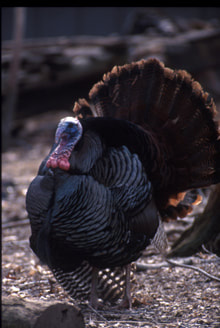|
As Thanksgiving draws near, the iconic turkey takes center stage in households across the country as families gather together to give thanks over a traditional turkey dinner. The domesticated turkey which graces most tables is descended from one of six subspecies of the wild turkey (Meleagris gallopavo). In the 1500s, a century before English settlers founded Plymouth Rock, Spanish traders brought this large game bird to Europe and Asia via shipping routes that passed through the country of Turkey, giving the bird its common name. Here in Ohio, the wild turkey is the largest upland game bird, weighing in up to 24 pounds! Being a woodland species, these birds suffered from being over hunted and habitat destruction of forest lands in the late 1800s and were extirpated from the state by 1904. However by the 1940s, forests were beginning to regrow allowing turkeys to return. From 1956 to 1963, the Ohio Department of Natural Resources tried, unsuccessfully, to introduce turkeys that had been hand raised. However, as natural populations increased, many were moved to other areas of the state. As of a survey conducted in 2017, turkeys live in all 88 Ohio counties, including here in Warren County! (Learn more about the wild turkey at: http://wildlife.ohiodnr.gov/species-and-habitats/species-guideindex/birds/wild-turkey) Today this highly adaptable bird thrives despite its conservation struggles of the past. And while wild turkeys are best known for their "gobble, gobble" call, this species utilizes a variety of calls for communicating in the flock. From a "cutt" to a "purr", these turkeys are talking! Practice your best turkey calls by mimicking these impressive birds! https://www.nwtf.org/hunt/wild-turkey-basics/turkey-sounds
0 Comments
|
Details
Warren County SWCD Staff BlogA blog to keep you informed on all the latest news at Warren County SWCD and in the conservation world. Archives
May 2024
Categories
All
|
|
|
Contact:PHONE: (513) 695 - 1337
EMAIL: [email protected] HOURS: Monday - Friday 7:30am - 4:00pm (except holidays) Connect:Warren County Soil & Water Conservation District Copyright © 2016
Warren SWCD Privacy Notice. Emails are serviced by Constant Contact. Constant Contact's Privacy Notice. |


